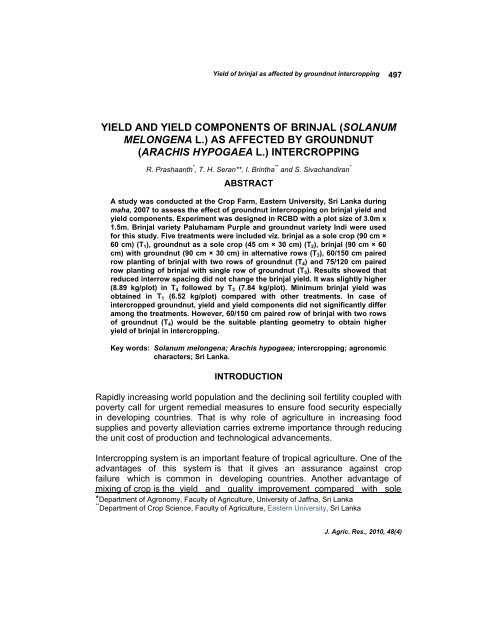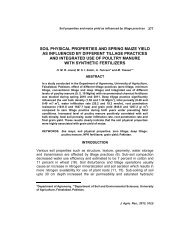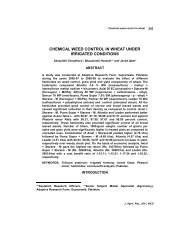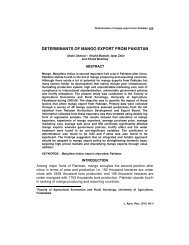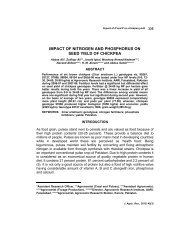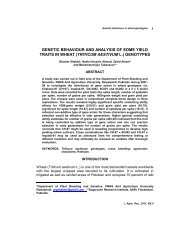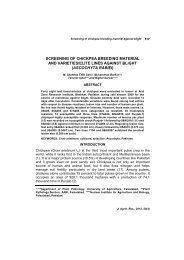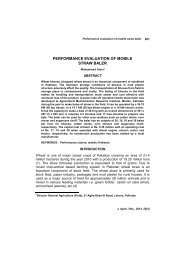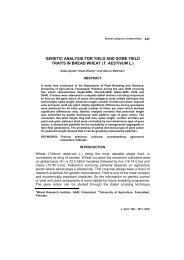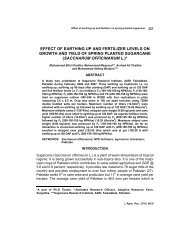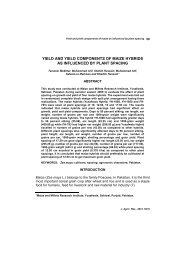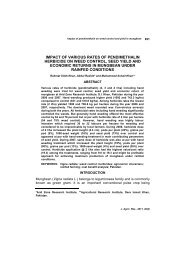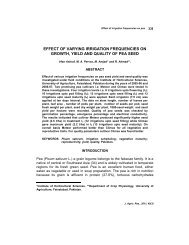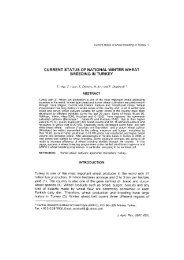Solanum melongena L. - Journal of Agricultural Research
Solanum melongena L. - Journal of Agricultural Research
Solanum melongena L. - Journal of Agricultural Research
You also want an ePaper? Increase the reach of your titles
YUMPU automatically turns print PDFs into web optimized ePapers that Google loves.
Yield <strong>of</strong> brinjal as affected by groundnut intercropping 497<br />
YIELD AND YIELD COMPONENTS OF BRINJAL (SOLANUM<br />
MELONGENA L.) AS AFFECTED BY GROUNDNUT<br />
(ARACHIS HYPOGAEA L.) INTERCROPPING<br />
R. Prashaanth * , T. H. Seran**, I. Brintha ** and S. Sivachandiran *<br />
ABSTRACT<br />
A study was conducted at the Crop Farm, Eastern University, Sri Lanka during<br />
maha, 2007 to assess the effect <strong>of</strong> groundnut intercropping on brinjal yield and<br />
yield components. Experiment was designed in RCBD with a plot size <strong>of</strong> 3.0m x<br />
1.5m. Brinjal variety Paluhamam Purple and groundnut variety Indi were used<br />
for this study. Five treatments were included viz. brinjal as a sole crop (90 cm ×<br />
60 cm) (T 1 ), groundnut as a sole crop (45 cm × 30 cm) (T 2 ), brinjal (90 cm × 60<br />
cm) with groundnut (90 cm × 30 cm) in alternative rows (T 3 ), 60/150 cm paired<br />
row planting <strong>of</strong> brinjal with two rows <strong>of</strong> groundnut (T 4 ) and 75/120 cm paired<br />
row planting <strong>of</strong> brinjal with single row <strong>of</strong> groundnut (T 5 ). Results showed that<br />
reduced interrow spacing did not change the brinjal yield. It was slightly higher<br />
(8.89 kg/plot) in T 4 followed by T 3 (7.84 kg/plot). Minimum brinjal yield was<br />
obtained in T 1 (6.52 kg/plot) compared with other treatments. In case <strong>of</strong><br />
intercropped groundnut, yield and yield components did not significantly differ<br />
among the treatments. However, 60/150 cm paired row <strong>of</strong> brinjal with two rows<br />
<strong>of</strong> groundnut (T 4 ) would be the suitable planting geometry to obtain higher<br />
yield <strong>of</strong> brinjal in intercropping.<br />
Key words: <strong>Solanum</strong> <strong>melongena</strong>; Arachis hypogaea; intercropping; agronomic<br />
characters; Sri Lanka.<br />
INTRODUCTION<br />
Rapidly increasing world population and the declining soil fertility coupled with<br />
poverty call for urgent remedial measures to ensure food security especially<br />
in developing countries. That is why role <strong>of</strong> agriculture in increasing food<br />
supplies and poverty alleviation carries extreme importance through reducing<br />
the unit cost <strong>of</strong> production and technological advancements.<br />
Intercropping system is an important feature <strong>of</strong> tropical agriculture. One <strong>of</strong> the<br />
advantages <strong>of</strong> this system is that it gives an assurance against crop<br />
failure which is common in developing countries. Another advantage <strong>of</strong><br />
mixing <strong>of</strong> crop is the yield and quality improvement compared with sole<br />
*Department <strong>of</strong> Agronomy, Faculty <strong>of</strong> Agriculture, University <strong>of</strong> Jaffna, Sri Lanka<br />
** Department <strong>of</strong> Crop Science, Faculty <strong>of</strong> Agriculture, Eastern University, Sri Lanka<br />
J. Agric. Res., 2010, 48(4)
498<br />
Prashaanth et al.<br />
cropping. The biological advantage <strong>of</strong> intercropping comes from<br />
complimentary use <strong>of</strong> growth resources. In addition, competition from weeds<br />
may be reduced by a combination <strong>of</strong> crop species occupying two or more<br />
niches in the field (1). The value <strong>of</strong> intercropping system has been gaining<br />
recognition because <strong>of</strong> its ability to reduce damage caused by pest and<br />
diseases, ensure greater yield stability by producing some yield even though<br />
some <strong>of</strong> the component crops failed (4).<br />
In Sri Lanka, brinjal (<strong>Solanum</strong> <strong>melongena</strong> L.) and groundnut (Arachis<br />
hypogaea L.) are the important vegetable and pulse crops, respectively.<br />
Brinjal, belonging to family Solanaceae, is the most common and popular<br />
vegetable crop in Sri Lanka for local and export market. It is a hardy plant<br />
compared to other vegetables grown in Sri Lanka. Due to this character, it<br />
can be successfully grown in very dry areas under rainfed conditions or with<br />
minimum irrigation facilities. It is highly productive and usually finds its place<br />
as a poor man's crop. Fruit is the important part <strong>of</strong> brinjal and has<br />
economical, nutritional and medicinal properties. One hundred gram edible<br />
portion has 1.4 g protein, 4 g carbohydrates, and considerable amount <strong>of</strong><br />
copper, potassium, sulphur, chlorine, calcium, magnesium, phosphorus, iron<br />
and vitamins (2,3). Groundnut a leguminous crop, is grown for seeds, oil,<br />
meal and vegetable residues. It is a commercial oilseed crop and described<br />
as ‘King <strong>of</strong> oilseed’ in Indian agriculture. It has high content <strong>of</strong> protein and oil.<br />
One hundred gram raw groundnuts contain about 47.5 g oil and 26 g protein.<br />
One hundred gram roasted nuts have composition <strong>of</strong> 48.7 g oil and 26 g<br />
protein and also rich in P, vitamins, rib<strong>of</strong>lavin and niacin (2,3). Theoretically,<br />
growth resources used by the component crops over time and space may be<br />
different, and when appropriate combinations <strong>of</strong> crops are adopted together,<br />
efficiency <strong>of</strong> resource use is greater than that <strong>of</strong> mono-cropping.<br />
Due to local adaptability and high nutritive value <strong>of</strong> both brinjal and<br />
groundnut, this study was aimed to select the suitable brinjal and groundnut<br />
intercropping system in sandy regosol.<br />
MATERIALS AND METHODS<br />
This study was conducted during the year 2007 at the Crop Farm, Eastern<br />
University, Sri Lanka located in low country dry zone. Annual rainfall ranges<br />
from 1600 mm-2300 mm and temperature from 25ºC - 39ºC. The soil at<br />
experimental site is sandy regosol. There were five treatments replicated<br />
thrice. Experiment was designed in a RCBD with plot size <strong>of</strong> 3.0 m x 1.5 m.<br />
Five treatments viz. brinjal as a sole crop (90 cm × 60 cm) (T 1 ), groundnut as<br />
a sole crop (45 cm × 30 cm) (T 2 ), brinjal (90 cm × 60 cm) with groundnut (90<br />
J. Agric. Res., 2010, 48(4)
Yield <strong>of</strong> brinjal as affected by groundnut intercropping 499<br />
cm × 30 cm) in alternative rows (T 3 ), 60/150 cm paired row planting <strong>of</strong> brinjal<br />
with two rows <strong>of</strong> groundnut (T 4 ) and 75/120 cm paired row planting <strong>of</strong> brinjal<br />
with single row <strong>of</strong> groundnut (T 5 ) were included.<br />
Brinjal seeds (cv. Paluhamam Purple) were sown in nursery and transplanted<br />
to field at three weeks after sowing. Groundnut seeds (cv. Indi) were sown<br />
directly in field one week after brinjal planting. As basal dose urea (75 kg/ha),<br />
triple super phosphate (335 kg/ha) and muriate <strong>of</strong> potash (85 kg/ha) were<br />
applied to brinjal. At 4 th , 8 th and 12 th week after transplanting (WAT) urea @<br />
75 kg, urea @ 75 kg with 85 kg muriate <strong>of</strong> potash and urea @ 75 kg per<br />
hectare were applied as top dressing, respectively. For groundnut, urea, triple<br />
super phosphate and muriate <strong>of</strong> potash were applied as basal dose @ 35,<br />
140 and 75 kg per hectare, respectively and at time <strong>of</strong> flowering urea @ 30<br />
kg was applied as top dressing. Different traits such as 50 percent flowering,<br />
number <strong>of</strong> flowers, fruit length and girth, number <strong>of</strong> fruits per plant and fruit<br />
yield per plot were measured in brinjal. In groundnut, number <strong>of</strong> pods per<br />
plant, number <strong>of</strong> seeds per pod, dry weight <strong>of</strong> 100 seeds and shelling<br />
percentage were recorded. Data were analyzed by using SAS version. The<br />
means were compared using Duncan’s multiple range test at 5 percent<br />
significant level.<br />
Brinjal<br />
RESULTS AND DISCUSSION<br />
50% flowering: Brinjal plant reached 50 percent flowering between 6 th and<br />
8 th WAT. It attained 50 percent flowering in 6 and 7 weeks in T 1 and T 3 ,<br />
respectively whereas in T 4 and T 5 it reached this stage in 8 weeks (Table 1).<br />
Theoretically nitrogen leads to increase vegetative period and delay<br />
reproductive phase, while groundnut has ability to fix atmospheric nitrogen. In<br />
this study, in intercropping treatments, delayed flowering <strong>of</strong> brinjal may be the<br />
reason <strong>of</strong> nitrogen. Large amount <strong>of</strong> nitrogen produces excessive vegetative<br />
growth and delays the reproductive growth considerably (13). Light is an<br />
essential for photosynthesis and affects flowering in plants as well as<br />
reproduction. In this study, number <strong>of</strong> weeks to 50 percent flowering was not<br />
remarkably changed by any <strong>of</strong> the treatments which suggests that 50 percent<br />
flowering in brinjal was not affected by intercropping with groundnut.<br />
J. Agric. Res., 2010, 48(4)
500<br />
Prashaanth et al.<br />
Table 1.<br />
Number <strong>of</strong> weeks to reach 50% flowering in brinjal.<br />
Treatments<br />
Weeks to reach 50% flowering<br />
T 1 6+0.33<br />
T 3 7+0.33<br />
T 4 8+0.6<br />
T 5 8+0.58<br />
F. test NS<br />
Number <strong>of</strong> flowers: T 1 (brinjal as sole crop) significantly differed from other<br />
treatments at 4 th WAT. Thereafter, difference in number <strong>of</strong> flowers in brinjal<br />
was non-significant (Table 2). In this experiment, competition for resources<br />
seemed to be lower which led to give non-significant results in treatments.<br />
Unfavorable conditions, cultivation practices, low soil fertility and low light<br />
enhance the flower drop (8, 10).<br />
Table 2.<br />
Number <strong>of</strong> flowers per plant at two weeks interval.<br />
Treatments At 4 th week after<br />
transplanting<br />
At 8 th week after<br />
transplanting<br />
At 12 th week after<br />
transplanting<br />
T 1 2 ± 0.33 a 1 ± 0.33 1 ± 0.00<br />
T 3 0 ± 0.00 b 1 ± 0.33 1 ± 0.00<br />
T 4 1 ± 0.33 b 1 ± 0.33 1 ± 0.33<br />
T 5 1 ± 0.33 b 1 ± 0.00 1 ± 0.67<br />
F test * NS NS<br />
Value represents mean ± standard error <strong>of</strong> three replicates, F test::-*Significant (P < 0.05); NS:<br />
Non-significant. Means followed by the same letter did not significantly differ according to<br />
Duncan’s multiple range test at 5% level.<br />
Length and girth <strong>of</strong> fruit: The fruit length was not influenced by any <strong>of</strong> the<br />
treatments (Table 3). T 1 gave higher value at 8 th WAT fruit (15 cm length and<br />
11.3 cm girth). From 10 th week onwards fruit length was high in intercropping<br />
treatments (14.3 and 13.0 cm) compared to sole cropping (8.2 and 10.8 cm).<br />
The girth <strong>of</strong> fruit also was not influenced by any <strong>of</strong> the treatments at 8 th and<br />
12 th WAT but significantly differed (P < 0.05) at 10 th week (Table 3).<br />
Table 3.<br />
Length and girth <strong>of</strong> fruit (cm) at two week intervals.<br />
Treatment At 8 th week At 10 th week At 12 th week<br />
s<br />
Length Girth Length Girth Length Girth<br />
T 1 15 ± 7.93 11.3 ± 5.69 13.2 ± 6.62 10.0 ± 5.00 ab 08.2 ± 5.25 05.2 ± 5.17<br />
T 3 13 ± 6.76 09.6 ± 4.84 23.0 ± 0.92 18.8 ± 0.44 a 10.8 ± 5.41 11.0 ± 5.34<br />
T 4 07 ± 6.66 05.6 ± 5.66 22.8 ± 0.44 17.6 ± 0.55 ab 14.3 ± 7.17 10.2 ± 5.13<br />
T 5 06 ± 6.33 04.6 ± 4.67 16.6 ± 6.66 15.5 ± 5.50 b 13.0 ± 6.50 10.7 ± 5.34<br />
F test NS NS NS * NS NS<br />
Value represents mean ± standard error <strong>of</strong> three replicates, F test:-*Significant (P < 0.05; NS:<br />
Not significant. Means followed by the same letter did not significantly differ according to<br />
Duncan’s multiple, range test at 5% level.<br />
J. Agric. Res., 2010, 48(4)
Yield <strong>of</strong> brinjal as affected by groundnut intercropping 501<br />
At this stage girth <strong>of</strong> fruit in T 3 was higher than other treatments. Groundnut<br />
has ability to fix nitrogen and nitrogen may be high in intercropped treatments<br />
compared to sole cropping, which may increase length and girth <strong>of</strong> fruit in<br />
intercropped treatments. Som and Maity (11) also found that length, diameter<br />
and volume <strong>of</strong> brinjal fruit responded positively to increased nitrogen.<br />
Number <strong>of</strong> fruits per plant and brinjal yield: There was no significant effect<br />
on number <strong>of</strong> fruits due to planting patterns (Table 4). Number <strong>of</strong> fruits per<br />
plant was high in T 1 (8) and T 3 (7) compared to T 4 and T 5 (6 each). However,<br />
there was no significant difference among treatments. The results suggest<br />
that number <strong>of</strong> fruits was not affected by planting pattern.<br />
Table 4.<br />
Number <strong>of</strong> fruit per plant and pod yield (kg/plot).<br />
Treatments Number <strong>of</strong> fruits/plant Fruits yield (kg/plot)<br />
T 1 8 ± 1.55 6.52<br />
T 3 7 ± 1.55 7.84<br />
T 4 6 ± 0.58 8.89<br />
T 5 6 ± 1.22 7.72<br />
F test NS NS<br />
Value represents mean ± standard error <strong>of</strong> three replicates.<br />
F test: NS: Non-significant.<br />
Fruit yield was high in T 4 (8.89 kg/plot) while T 1 (sole brinjal) produced the<br />
lowest (6.52 kg) (Table 3). It may be due to fixation <strong>of</strong> nitrogen by groundnut<br />
intercropping compared with that <strong>of</strong> mono-cropping. The beneficial effects <strong>of</strong><br />
nitrogen in increasing the production <strong>of</strong> brinjal have also been reported by<br />
Verma and Choudhury (12). Non-significant differences (P > 0.05) in yield<br />
may be due to constant fruit number <strong>of</strong> brinjal in each treatment. Sivaraman<br />
and Palaniappan (10) also report similar findings.<br />
Groundnut<br />
Number <strong>of</strong> pods: Number <strong>of</strong> pods per plant in groundnut was not affected by<br />
any <strong>of</strong> the treatments (Table 5). Positive correlation between number <strong>of</strong> pods<br />
and pod yield has earlier been reported (8). Efficiency <strong>of</strong> absorption <strong>of</strong><br />
nutrients is high in pegs than roots. At peg there is no translocation and it<br />
directly converts into pods. In this experiment, there is no significant<br />
difference in pod number. It suggests that number <strong>of</strong> pods per plant was not<br />
affected by brinjal intercropping. Low light intensity at pegging reduces peg<br />
and pod number in groundnut (8).<br />
J. Agric. Res., 2010, 48(4)
502<br />
Prashaanth et al.<br />
Number <strong>of</strong> seeds per pod: There was no significant differences (P > 0.05)<br />
among treatments also in number <strong>of</strong> seeds per pod (Table 5). It ranged from<br />
Table 5.<br />
Yield components <strong>of</strong> groundnut<br />
Treatments Pod number/<br />
plant<br />
Number <strong>of</strong><br />
seeds/pod<br />
100 seed dry<br />
weight (g)<br />
Shelling<br />
percentage<br />
T 2 26 ± 2.40 2.15 ± 0.08 58.37 ± 03.44 77.67 ± 1.49<br />
T 3 24 ± 3.18 2.12 ± 0.35 54.80 ± 16.74 77.48 ± 0.37<br />
T 4 18 ± 6.17 2.28 ± 0.83 57.90 ± 36.80 75.64 ± 0.14<br />
T 5 25 ± 4.91 2.24 ± 0.48 61.01 ± 21.37 77.36 ± 0.96<br />
F test NS NS NS NS<br />
Value represents mean ± standard error <strong>of</strong> three replicates.<br />
NS = Non-significant.<br />
2.12 (T 3 ) to 2.28 (T 4 ). Reddy (8) reported that number <strong>of</strong> groundnut seeds per<br />
pod varies from two to six. Theoretically kernel number is controlled by<br />
genetic factors and also influenced by internal competition. Yield components<br />
are more sensitive to environmental stress during kernel growth stage (8). In<br />
this experiment, competition for resources may be lower which led to give<br />
non-significant results in treatments. Plant population <strong>of</strong> groundnut did not<br />
influence the number <strong>of</strong> kernels per pod (6).<br />
100-seed dry weight: This trait also did not significantly differ among the<br />
treatments (Table 5). Among intercropping treatments, it was higher in T 5<br />
(61.01 g) and lower in T 3 (54.80 g). Gopalaswamy et al. (5) found that<br />
decreasing plant population increased weight <strong>of</strong> 100 seeds.<br />
Shelling percentage: Shelling percentage was also not influenced by the<br />
treatments (Table 5). It ranged from 75.64 (T 4 ) to 77.67 percent (T 2 ).<br />
Gopalaswamy et al. (5) reported that plant density did not affect shelling<br />
percentage.<br />
CONCLUSION<br />
The results conclude that reduced inter-row spacing did not significantly (P ><br />
0.05) change brinjal yield. The yield <strong>of</strong> brinjal was slightly high (8.89 kg/plot)<br />
in T 4 followed by T 3 (7.84 kg/plot) against minimum in T 1 (6.52 kg/plot). It may<br />
be due to high water evaporation in soil due to absence <strong>of</strong> intercrop cover. T 4<br />
had optimal number <strong>of</strong> plants in proper planting geometry and yield <strong>of</strong> base<br />
crop (brinjal) was high (8.89 kg/plot). In case <strong>of</strong> intercropped groundnut,<br />
parameters did not significantly differ among the treatments. Treatment <strong>of</strong><br />
60/150 cm paired row <strong>of</strong> brinjal with two rows <strong>of</strong> groundnut (T 4 ) proved as<br />
suitable planting geometry to obtain higher yield in intercropping.<br />
J. Agric. Res., 2010, 48(4)
Yield <strong>of</strong> brinjal as affected by groundnut intercropping 503<br />
REFERENCES<br />
1. Altieri, M. A. and M. Liebman. 1986. Insect, weed and plant disease<br />
management in multiple cropping systems. In: Multiple Cropping<br />
Systems. Francis, C.A (ed.). p. 183-217. Macmillan Publishing<br />
Company, New York.<br />
2. Anon. 1998. Techno Guide, Part 1. Department <strong>of</strong> Agriculture, Sri<br />
Lanka. p. 178-183.<br />
3. Anon. 1998. Techno Guide, Part 2. Department <strong>of</strong> Agriculture, Sri<br />
Lanka. Pp. 5.<br />
4. Blade, S. E., S. V. R. Shetty, I. Terao and B. B. Singh. 1997. Recent<br />
Developments in Cowpea Cropping Systems <strong>Research</strong>. In: Advances in<br />
Cowpea <strong>Research</strong>. Co-production <strong>of</strong> IITA and JIRCAS, IITA Ibadan,<br />
Nigeria. p. 114-128.<br />
5. Gopalaswamy, N., R. Eleangovan and C. Rajah. 1979. Agronomic and<br />
economic optimum plant densities for rainfed groundnut. Indian J. Agric.<br />
Sci. 49(1):17-21.<br />
6. John, N., F. C. Dalmo, D.S.N. Gessy, P. D. S. N. Joao, N. D. S.<br />
Mauricio, S. S. Veraguas, V. Barbosa and A. V. R. Claudia. 2000. Plant<br />
density and yield <strong>of</strong> peanut. Sci. Agric. 57: 67-73.<br />
7. Macit, F. and W. Gotz. 1971. Influence <strong>of</strong> gibberellic acid on the fruit set<br />
<strong>of</strong> eggplant (<strong>Solanum</strong> <strong>melongena</strong> L.) (Turkish, Ger. Summ.). Res. Rep.<br />
Fac. Agric. Izmir. p. 91-98.<br />
8. Reddy, S. R. 2006. Agronomy <strong>of</strong> Field Crop. Kalyani Publisher, India. p.<br />
379-419.<br />
9. Saito, T. and H. Itah. 1973. Studies on the flowering and fruiting in<br />
eggplant. VII. Effects <strong>of</strong> early enviornmental conditions and cultural<br />
treatments on the development and drop <strong>of</strong> flowers. (Japanese, Eng.<br />
Summ). J. Jpn. Soc. Hortic. Sci. 42: 155-162.<br />
10. Sivaraman, K. and S. P. Palaniappan. 1996. Cropping Systems in the<br />
Tropics - Principles and Management. New Age International Ltd, India.<br />
p. 28-150.<br />
11. Som, M. G. and T. K. Maity. 1993. Brinjal. In: Vegetable Crops. Bose, T.<br />
K., M. G. Som and J. Kabir (eds.). p. 293. Naya Prokash, India.<br />
12. Verma, T. S. and B. Choudhury. 1974. Screening <strong>of</strong> brinjal (<strong>Solanum</strong><br />
<strong>melongena</strong> L.) against root-knot nematodes (Meloidogyne spp.). Veg.<br />
Sci. 1: 55-61.<br />
13. Vishnu, S. 2006. Vegetable Science and Technology in India. Kalyani<br />
Publishers, India. p. 125.<br />
J. Agric. Res., 2010, 48(4)


